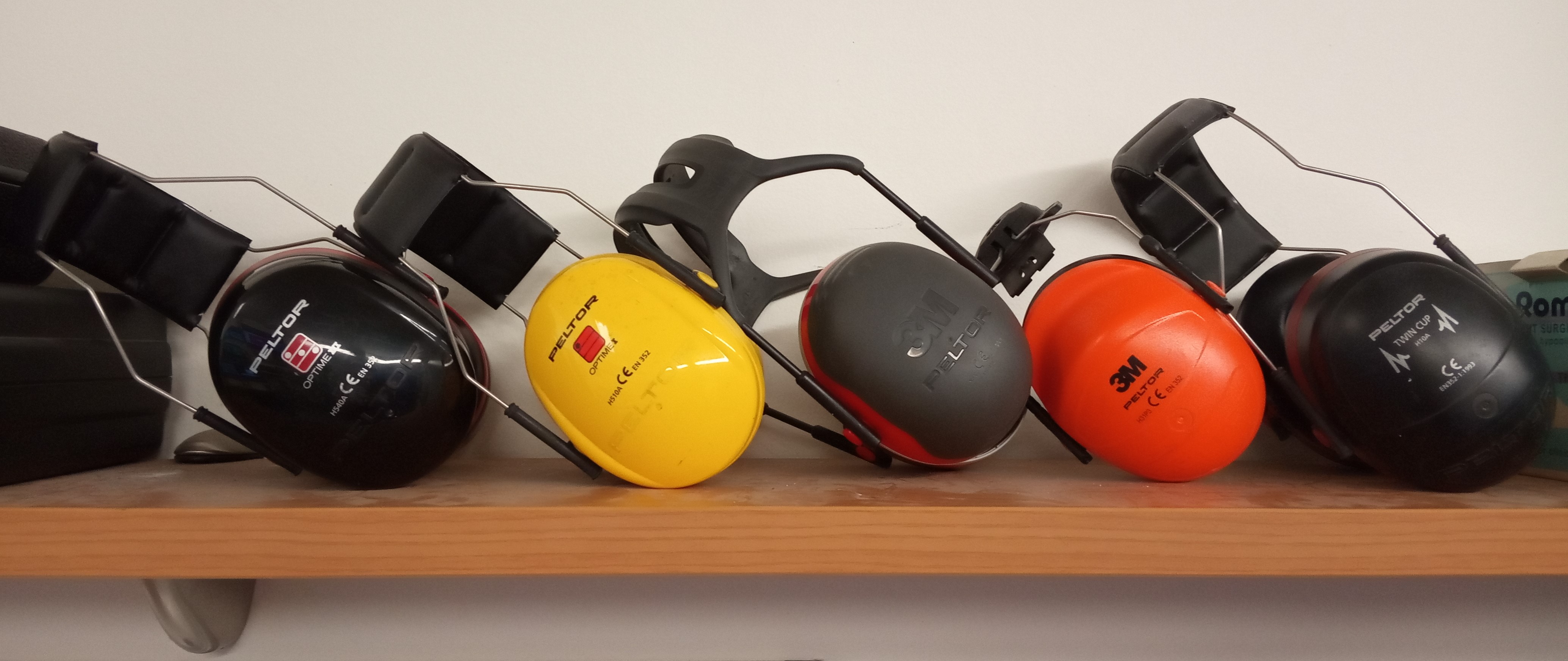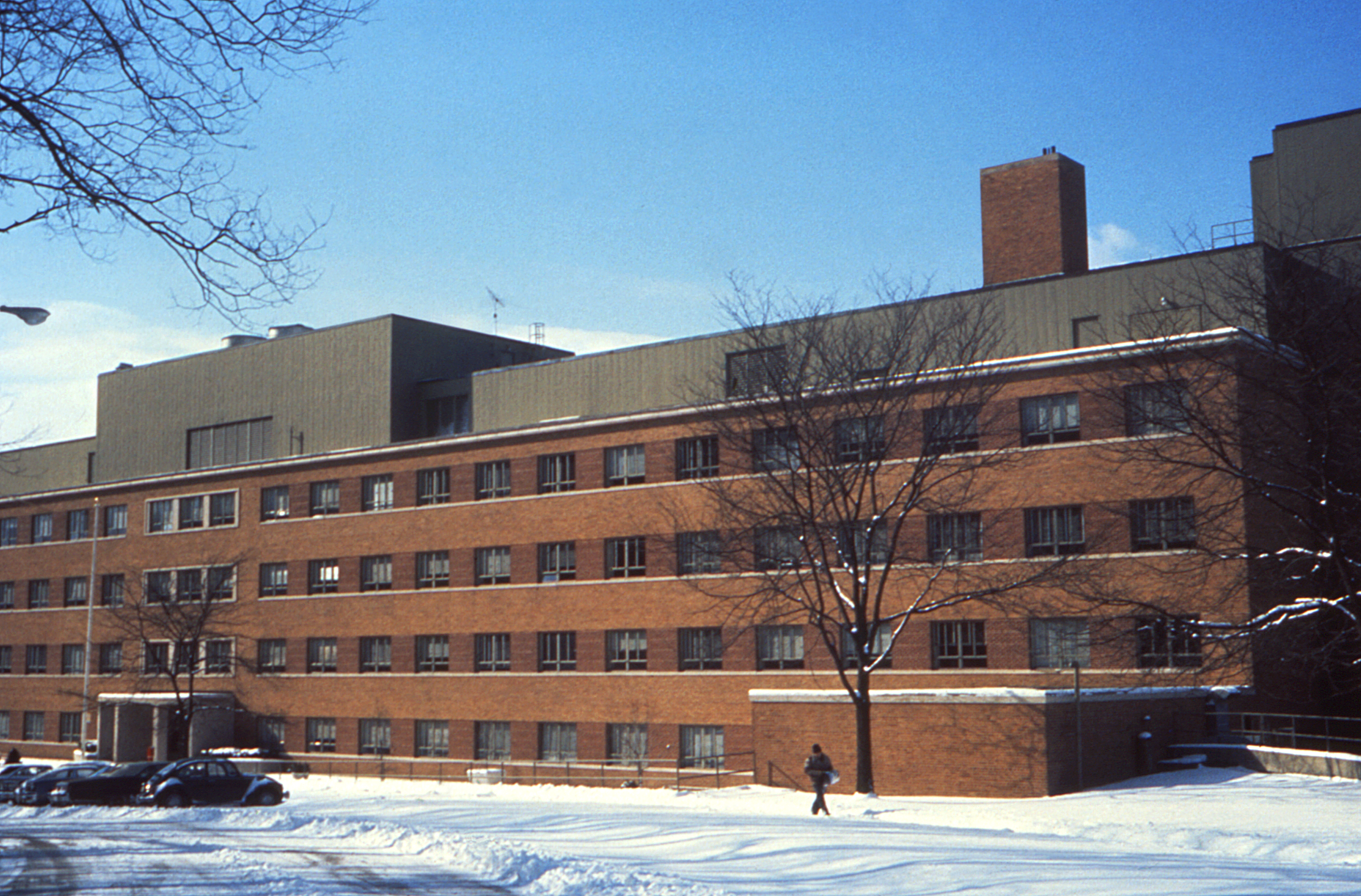|
Earmuff
Earmuffs are accessories designed to cover a person's ears either for warmth or for hearing protection. Both types of earmuff consist of a thermoplastic or metal head-band that fits over the top or back of the head, and a cushion or cup at each end to usually cover both ears. Hearing protection earmuffs are a type of personal protective equipment. Cold weather History Thermal earmuffs were invented by Chester Greenwood of Farmington, Maine in 1873, when he was 15. He reportedly conceived the idea while ice skating, and asked his grandmother to sew tufts of fur between loops of wire. His patent was for improved ear protectors, which he and his local employees manufactured in the Farmington area for nearly 60 years. Earmuffs vs. hats Thermal earmuffs are worn for protection from the cold. Because the ears extend from the sides of the head to gather sound waves, they have a high skin surface-area-to-volume ratio, and very little muscle tissue, causing them to be one of the fir ... [...More Info...] [...Related Items...] OR: [Wikipedia] [Google] [Baidu] |
Hearing Protection Device
A hearing protection device, also known as a HPD, is an ear protection device worn in or over the ears while exposed to hazardous noise and provide hearing protection to help prevent noise-induced hearing loss. HPDs reduce the level of the noise entering the ear. HPDs can also protect against other effects of Health effects from noise, noise exposure such as tinnitus and hyperacusis. There are many different types of HPDs available for use, including earmuffs, earplugs, electronic hearing protection devices, and semi-insert devices. The use of the HPD without individual selection, training and Hearing protection fit-testing, fit testing does not significantly reduce the risk of hearing loss. For example, one study covered more than 19 thousand workers, some of whom usually used hearing protective devices, and some did not use them at all. There was no statistically significant difference in the risk of noise-induced hearing loss. Exposure limits In the context of work, adequa ... [...More Info...] [...Related Items...] OR: [Wikipedia] [Google] [Baidu] |
Hearing Conservation Program
Hearing conservation programs''Larry H. Royster & Julia D. Royster''Hearing Conservation Programmes In: Vol. 2Chapter 47. Noise/Encyclopedia of Occupational Health and Safety/ Michel Hansenne ed. — 4th ed. — Geneva: International Labour Office, 1998. are programs that ''should'' reduce the risk of hearing loss due to hazardous noise exposure, if implemented correctly and with high quality. Hearing conservation programs require knowledge about risk factors such as noise and ototoxicity, hearing, hearing loss, protective measures to prevent hearing loss at home, in school, at work, in the military and, and at social/recreational events, and legislative requirements. Regarding occupational exposures to noise, a hearing conservation program is required by the Occupational Safety and Health Administration (OSHA) "whenever employee noise exposures equal or exceed an 8-hour time-weighted average sound level (TWA) of 85 decibels (dB) measured on the A scale (slow response) or, equivalen ... [...More Info...] [...Related Items...] OR: [Wikipedia] [Google] [Baidu] |
Noise-induced Hearing Loss
Noise-induced hearing loss (NIHL) is a Hearing loss, hearing impairment resulting from exposure to loud sound. People may have a loss of perception of a narrow range of Frequency, frequencies or impaired perception of sound including hyperacusis, sensitivity to sound or tinnitus, ringing in the ears. When exposure to hazards such as noise occur at work and is associated with hearing loss, it is referred to as occupational hearing loss. Hearing may deteriorate gradually from chronic and repeated noise exposure (such as loud music or background noise) or suddenly from exposure to impulse noise, which is a short high intensity noise (such as a gunshot or Air horn, airhorn). In both types, loud sound overstimulates delicate hearing cells, leading to the permanent injury or death of the cells. Once lost this way, hearing cannot be restored in humans. There are a variety of prevention strategies available to avoid or reduce hearing loss. Lowering the volume of sound at its source, ... [...More Info...] [...Related Items...] OR: [Wikipedia] [Google] [Baidu] |
Chester Greenwood
Chester Greenwood (December 4, 1858 – July 5, 1937) was an American engineer and inventor, known for inventing the earmuffs in 1873. He reportedly came up with the idea while ice skating and he asked his grandmother to sew tufts of fur between loops of wire. His patent was for improved ear protectors. He manufactured these ear protectors, providing jobs for people in the Farmington area for nearly 60 years. Career In 1873, aged 15, while he was testing a new pair of ice skates, he got frustrated as he tried to protect his ears from the cold. He then wrapped his head with a scarf, but was too itchy to wear. Greenwood was allergic to wool, so that neither the scarves nor the wool hats available in his time were viable options for him as protective head-coverings. Later, he designed two ear-shaped loops made by wire. He then asked his grandmother to sew fur on the loops. It successfully kept the cold away from his ears. He later improved the prototype earmuffs using a steel b ... [...More Info...] [...Related Items...] OR: [Wikipedia] [Google] [Baidu] |
Earplugs
An earplug is a device that is inserted in the ear canal to protect the user's ears from loud noises, intrusion of water, foreign bodies, dust or excessive wind. Earplugs may be used as well to improve sleep quality or focus in noisy environments. Since they reduce the sound volume, earplugs may prevent hearing loss and tinnitus (ringing of the ears), in some cases. US Occupational Safety and Health Administration requires hearing conservation programs which include the provision of hearing protection devices (HPDs). But this does not mean that OSHA considers HPDs to be effective. History The first recorded mention of the use of earplugs is in the Greek tale ''Odyssey,'' wherein Odysseus's crew is warned about the Sirens that sing from an island they will sail past. Circe, their hostess, tells them of the Sirens' bewitching song that makes men drive their boats ashore and perish. She advised Odysseus to fashion earplugs for his men from beeswax so they would not be lured to ... [...More Info...] [...Related Items...] OR: [Wikipedia] [Google] [Baidu] |
National Institute For Occupational Safety And Health
The National Institute for Occupational Safety and Health (NIOSH, ) is the List of United States federal agencies, United States federal agency responsible for conducting research and making recommendations for the prevention of work-related occupational injury, injury, occupational disease, illness, disability, and occupational fatality, death. Its functions include gathering information, conducting scientific research both in the laboratory and in the field, and translating the knowledge gained into products and services.About NIOSH National Institute for Occupational Safety and Health. Among NIOSH's programs are determination of recommended exposure limits for toxic chemicals and other hazards, field research such as the Health Hazard Evaluation Program, epidemiology and health surveillance programs such as the National Firefighter Re ... [...More Info...] [...Related Items...] OR: [Wikipedia] [Google] [Baidu] |
Hard Hat
A hard hat is a type of helmet predominantly used in hazardous environments such as industrial or construction sites to protect the Human head, head from injury due to falling objects (such as tools and debris), impact with other objects, and electric shock, as well as from rain. Suspension bands inside the helmet spread the helmet's weight and the force of any impact over the top of the head. A suspension also provides space of approximately 30 mm (1.2 inches) between the helmet's shell and the wearer's head, so that if an object strikes the shell, the impact is less likely to be transmitted directly to the skull. Some helmet shells have a mid-line reinforcement ridge to improve impact resistance. The Rock-climbing equipment#Helmet, rock climbing helmet fulfills a very similar role in a different context and has a very similar design. A bump cap is a lightweight hard hat using a simplified suspension or padding and a chin strap. Bump caps are used where there is a possibi ... [...More Info...] [...Related Items...] OR: [Wikipedia] [Google] [Baidu] |
Active Noise Control
Active noise control (ANC), also known as noise cancellation (NC), or active noise reduction (ANR), is a method for reducing unwanted sound by the addition of a second sound specifically designed to cancel the first. The concept was first developed in the late 1930s; later developmental work that began in the 1950s eventually resulted in commercial airline headsets with the technology becoming available in the late 1980s. The technology is also used in road vehicles, mobile telephones, earbuds, and headphones. Explanation Sound is a pressure wave, which consists of alternating periods of compression and rarefaction. A noise-cancellation speaker emits a sound wave with the same amplitude but with an inverted phase (also known as antiphase) relative to the original sound. The waves combine to form a new wave, in a process called interference, and effectively cancel each other out – an effect which is called destructive interference. Modern active noise control is gen ... [...More Info...] [...Related Items...] OR: [Wikipedia] [Google] [Baidu] |
Farmington, Maine
Farmington is a town in and the county seat of Franklin County, Maine, United States. As of the 2020 census, its population was 7,592. Farmington is home to the University of Maine at Farmington, Nordica Memorial Auditorium, the Nordica Homestead, and the annual Farmington Fair. History The area was once territory of the Canibas tribe of Abenaki Indians. They had two camps located near Farmington Falls, with fields cleared for cultivation of maize and potatoes. Their fort's stockade enclosed about an acre at the center of what is today Farmington Falls village. A group from Topsham arrived in 1776 to explore the area and lay out a town, called Plantation No. 1 or Sandy River Plantation, but permanent settlement was delayed by the Revolutionary War. In 1781, the first settlers arrived, the same year a sawmill was established. On February 1, 1794, Sandy River Plantation was incorporated as Farmington, named for its unusually fertile soil. Beginning with a cluster of log ho ... [...More Info...] [...Related Items...] OR: [Wikipedia] [Google] [Baidu] |
Personal Protective Equipment
Personal protective equipment (PPE) is protective clothing, helmets, goggles, or other garments or equipment designed to protect the wearer's body from injury or infection. The hazards addressed by protective equipment include physical, electrical, heat, chemical, biohazards, and airborne particulate matter. Protective equipment may be worn for job-related occupational safety and health purposes, as well as for sports and other recreational activities. ''Protective clothing'' is applied to traditional categories of clothing, and ''protective gear'' applies to items such as pads, guards, shields, or masks, and others. PPE suits can be similar in appearance to a cleanroom suit. The purpose of personal protective equipment is to reduce employee exposure to hazards when engineering controls and administrative controls are not feasible or effective to reduce these risks to acceptable levels. PPE is needed when there are hazards present. PPE has the serious limitation that it d ... [...More Info...] [...Related Items...] OR: [Wikipedia] [Google] [Baidu] |







